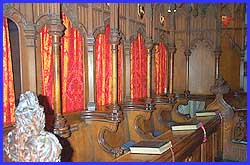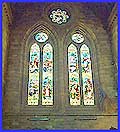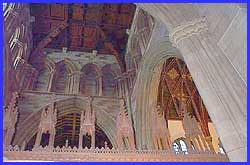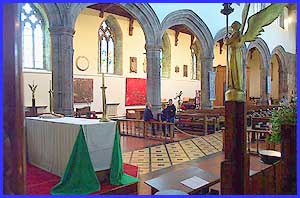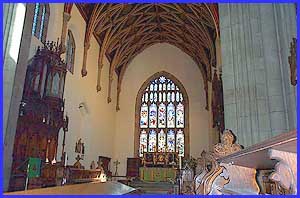
A Tranquil Refuge In A
Small But Busy City
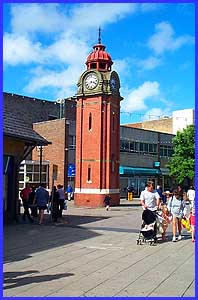 "Didn't
we have a lovely time the day we went to Bangor" was a line
in a song that was in the pop charts in December 1979. I believe
the town Fiddlers Dram were singing about in their hit "Day
Trip To Bangor" was in Ireland but the words could just
as easily have described our visit to the North Wales university
city of the same name. "Didn't
we have a lovely time the day we went to Bangor" was a line
in a song that was in the pop charts in December 1979. I believe
the town Fiddlers Dram were singing about in their hit "Day
Trip To Bangor" was in Ireland but the words could just
as easily have described our visit to the North Wales university
city of the same name.
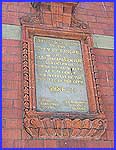 Standing at the northern end of the Menai Straits, traffic has
only restricted entry to the central area where there is a thriving
shopping precinct.
Standing at the northern end of the Menai Straits, traffic has
only restricted entry to the central area where there is a thriving
shopping precinct.
A prominent feature of this central area is the clock tower (left)
which, according to the inscribed plaque (right) was presented
to the city by "Alderman Thomas Lewis J.P. during his Mayorality
as a token of his interest in the welfare of the city 1886-7".
At the opposite end of the main street to the clock tower stands
Bangor's cathedral - the Church of Saint Deiniol.
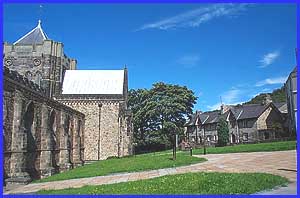
The Cathedral is thought to be the oldest in Britain in continuous
use having long been a Celtic centre for Christianity.
The building itself has seen continuous development since Norman
times and still shows much evidence of continuing development.
This owes much to Sir Gilbert Scott, who, in 1866, commenced
restoration with an eye to the past.
The photo left shows the approach to the Cathedral.
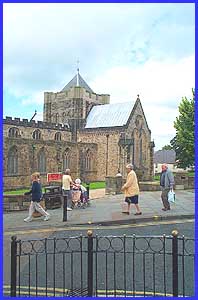
It was about the year 525AD that Deiniol first settled
on this site enclosing the area with a fence. The fence was constructed
by driving poles into the ground and weaving branches between
them. This was known as a "bangor" hence the origin
the the town's name.
Deiniol and his followers were missionaries and soon built a
church on the site. As the town grew a Celtic monastery or Clas
was formed.

By the middle of the sixth century, Deiniol's church had
become a cathedral but in 631 Bangor was sacked.
Over 400 years later it was the turn of the Vikings to rob and
burn the cathedral but about 1130 rebuilding of the cathedral
was commenced. King John's men again destroyed the cathedral
in 1211 but it rose again from the ashes well before the end
of the century.
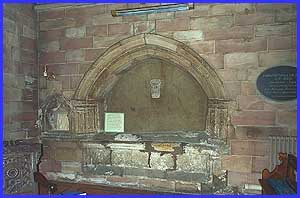
And so the rise and fall continued. In 1309 the central
tower burnt down and it was not until 1480 that rebuilding began
in earnest. Sir George Gilbert Scott's restoration took place
between 1870 and 1880 although the central tower was not completed.
This was eventually raised and capped with its pyramid in 1966.
Further major restoration commenced in 1987 and continues to
this day. As in St Deiniol's day, a friendly welcome awaits anyone
who crosses the threshold into the Cathedral.
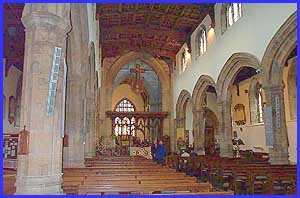 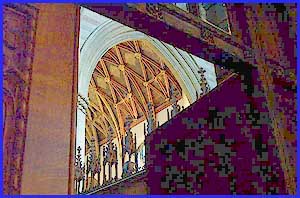
These two views above illustrate the nave (left) and the
impressive vaults of the presbytery (right) and the others below
illustrate many of the other features within the building.
|


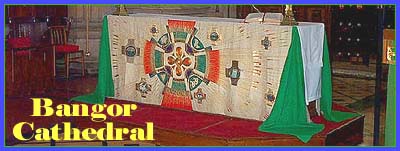
 "Didn't
we have a lovely time the day we went to Bangor" was a line
in a song that was in the pop charts in December 1979. I believe
the town Fiddlers Dram were singing about in their hit "Day
Trip To Bangor" was in Ireland but the words could just
as easily have described our visit to the North Wales university
city of the same name.
"Didn't
we have a lovely time the day we went to Bangor" was a line
in a song that was in the pop charts in December 1979. I believe
the town Fiddlers Dram were singing about in their hit "Day
Trip To Bangor" was in Ireland but the words could just
as easily have described our visit to the North Wales university
city of the same name. Standing at the northern end of the Menai Straits, traffic has
only restricted entry to the central area where there is a thriving
shopping precinct.
Standing at the northern end of the Menai Straits, traffic has
only restricted entry to the central area where there is a thriving
shopping precinct.





